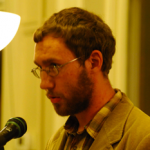Elizabeth Hatmaker, Guest Contributor
There will be a bright, shimmering, silver veil stretched every-
where tight, to hide the deep, black, empty, terrible bot-
tom of the world where people fall who are alone, or dead,
Sick or alone.
Alone or poor,
Weak, or mad, or doomed, or alone;
Kenneth Fearing
“American Rhapsody (3)”
How do you get between nowhere to somewhere? And how, then, you know when you’ve gotten, as Cain writes in Double Indemnity, “to the end of the line”? These used to be central existential questions in the films, novels, poetry, and lyric sensibilities we call noir. It’s certainly been argued that noir is a cosmopolitan form constructed from city iconographies and the pulse of commerce and commercialism, modernism and technology. Yet for everyone who will talk about the urban locales of novels like Hammett’s The Maltese Falcon or films like Dassin’s Naked City, I’ll counter with novels like Cain’s The Postman Always Rings Twice, Hammett’s Red Harvest, Dorothy Hughes’ Ride the Pink Horse or films like Siodmak’s The Killers. If the “someplaces” of noir are cosmopolitan spaces, noir’s “nowheres” are often not pastoral frontiers full of fresh possibilities, but inter-locations—roadside gas stations, industrial spurs, the tract homes of decreasing size, warehouses, exits reliant on tourists just traveling through to big cities or rural retreats.
While modernism idealizes movement and progress, noir often offers the ambivalent alternative to the freedom of movement, a profound sense of dislocation. The protagonists of noir are often escaping, hiding out, on the lamb, running away, or getting lost.
I am fascinated by the travel between somewhere and nowhere, through the interzones that represent neither the energy of the city nor the imagined and idealized frontier. I’m entranced especially by the physical markers of this affective transition. Sometimes you look around and you just know that suddenly you aren’t anyplace in particular anymore. You observe specific physical outliers that mark the edges of cultural signification and you confront their ambivalent affects.
Illinois is a figure divided by the I-80 corridor. Let’s not pretend otherwise. I-55 runs south almost all the way to New Orleans and north all the way to Lake Shore Drive. At mile maker 250, it is bisected by I-80, which runs from Teaneck, NJ, way out to San Francisco. It runs East-West just a little north of the Des Plaines River.
Above exists Chicago, the city and metro area with the largest population, large concert venues, tech corridors, “big city assholes,” a better selection of international food and cosmetics.
I live below, with flat land and solid people who mostly did not vote for Obama, “a couple hours south of the city” to my friends in California. I live in a cancer belt in a nice and affordable craftsman house. I live down here in central Illinois with the Spoon River for which this journal was named. Spoon River is truly lovely. Central Illinois is not nowhere.
The intersection of I-55 and I-80 is in Joliet, IL. Joliet itself is a fine town. It was once home to two famous prisons that you’ve probably heard referenced in many Chicago noirs. Going to Joliet used to have a very specific noir meaning. Now one of the prisons is closed.
A recent highway project along I-55 erected sound barriers along several miles so as to afford local homeowners some privacy and noise control. Recent efforts to build a new mall at the intersection of these two highways seems to have stalled although boarded up homes, originally slated for demolition, still dot the frontage road. Within two miles there is a hotel owned by the Elks Club. Billboards along the highway advertise casinos, laser medical procedure, car dealerships, and the Merrimac Caverns, which are located way down in Missouri.
What might make a landscape lyrically noir? I suppose I return to Elizabeth Willis’s definition of the lyric voice as a figure in which the landscape is phenomenalized. If we look at two prime examples of “noir poetry,” both Kenneth Fearing’s Dead Reckoning or Nelson Algren’s Chicago: City on the Make create specific political and aesthetic landscapes of downward mobility. Both use a pop culture pastiche to suggest the lost lonely urban figures, beautiful and doomed. Yet like much post-noir iconography, its translation into our current neo-liberal landscape can seem both naïve and melancholic; the attractions and terrors of mid-century America have played out, after all. Noir nostalgia continues to play on in the beautiful pictures of decaying mansions and public buildings or when we consider evidence that cities like Detroit or even parts of Chicago are dying. We feel it when we sense the industrial beams falling to earth or when we smell the rust from the Des Plaines and feel I-55, scorched at the guardrails, curling in a bit on us.
History mediates and re-mediates roads to somewhere—the future, success, freedom—as a kind of infrastructure of our desires. At the same time counter-landscapes—the past, regret, ambivalence, rejection—wink at us, still demanding the status of place or matter.
In contemporary noir studies, Patrick Blaine describes Chilean writer Ramón Díaz Eterovic’s hard-boiled Heredia series. The power of the Heredia series, Blaine argues, is based. . .“less on the resolution of crimes than on a collective effort to restore a lost past which has been forcefully and artificially extirpated. It also resists the present aesthetic paradigms (as strong as their pull might be), based on the psychology of the market, which imposes a constant, forced obsolescence on all aspects of life, flattening affect and relying on the empty repetition of patterns of communication.”
At mile marker 238 there is a dead exit at Braidwood/IL 129. From South I-55, drivers used to be able to exit via a left lane U turn through the central reservation to merge with southbound traffic. From the southbound left lane, travelers could exit and cross over the northbound lane via an overpass that has, over time, become unstable and dangerous. For about nine months signs for the exit remained, marking movement no longer possible. Barriers were erected and the pavement was broken up and removed and now significant prairie grass grows as if Illinois has simply consumed its own idea. To the casual onlooker, all that remains is a single light to mark the dead.
Braidwood is home to a nuclear facility that powers much of the Chicagoland metro area. I can never not see a whole story in my mind on dark rides back from the city, down under I-80, headed towards the south.
There are vague plans to re-design the entire infrastructure in Will County south of the Des Plaines River. Attention is currently focused on the Arsenal Road exit at mile marker 245 as it is home to both an ExxonMobil Refinery and the CenterPoint Intermodal Center, apparently the largest trucking hub in the nation. This exit is home to the now defunct Joliet Army Ammunitions Plant, which operated through the 1970s. It is current site of a military cemetery. Other portions of the former plant are listed as sites on the EPA Superfund list.
Current road construction often strands drivers on the Des Plaines River Bridge in the range between static and audibility; many popular Chicago radio stations—de facto public spaces—seem to phase out at this boundary. This is not a story about Illinois and yet here Illinois is.
Marc Augé describes the spaces I mean as “non-spaces.” They are recursive, evasive, and out of sync with the systems of meaning that traditionally define identity, space, and temporality. Yet non spaces are replete with words or “instructions for use” with which we are encouraged to enact with words as identity and landscape in the most mundane ways. The far left lane ends after Bluff Road; you no longer require three lanes for your automobility.
Yet the buried pasts, the deconstructed meanings of dead exits, the nowhere of identity, suggest that non-spaces might be productively imagined as noir spaces, that interchange between here and someplace better or worse. In these spaces, in this lyric sensibility expressed in film, novels, and landscape, we unravel the strange routes between desires and demands enforced by billboards and our melancholia for a lost and equally conflicted past.
Try 5 on the dial, try 10, 15
Just the ghost of an inch, did you know, divides Japan and
Peru?
20, 25
Is that what you want, static and a speech and the fragment of a
waltz, is that just right?
Kenneth Fearing
“Radio Blues”
In Natsuo Kirino’s 1997 noir novel Out, the female protagonists work at a bento factory in what is politely called the “Tokyo suburbs.” They actually work the Mushashi-Murayama district, and if you look on Google maps you will see that it is nowhere where anyone, including sex tourists, would ever go in Tokyo. It is as much of the world is, an interlinking set of highways and factories and houses and malls. The novel’s progression takes its protagonists through a series of locations that are out, intertubes encouraging meditation on the physical conditions of their increasing alienation as they progress from one sense of out to another.
Popular among the growing market for novels many would term “global noir” are those by Scandinavian authors Henning Mankell, Camilla Läckburg, Arnuldar Indriðason, and Stieg Larsson. Although there remains much focus on how these writers engage gender oppression, multiculturalism, and the long and complex memory of Nazi collaboration and resistance, often the novelists rely on settings—summer tourist villages, small ferry ports and (in Indriðason’s case, a county) both isolated from and central to global trade and tourism. These places are inter-zones too, vulnerable to the inter-reliance between EU capitalism and socialism, between white nationalist violence and the exploitation of global labor. In these places, on these emptying highways, between cosmopolitanisms, at these travel stops, all global noir subjects feel the increased pressure to become convenient and hospitable to investments possibilities.
At I-55 Bolingbrook exit 267, there once stood an abandoned mall known as Old Chicago. Modeled on early 20th century Chicago designs, the mall, which opened in 1975, featured small boutiques instead of larger mainstream stores. Inside the store, among the small batch product stood a bright yellow roller coaster, a log ride, rides and rides—a whole fair, a reminder of the Chicago World’s Fair and other lost public spaces of populist excitement. And yet it failed by 1980. Rumor at the time was that too many black kids came and scared the white kids and their parents off. I’m sure that the business of malls is simultaneously both more complex and more simple than that.
If you’ve seen the 1978 Brian De Palma film The Fury, you’ve seen Old Chicago. It seems like an idea that could never work. And it didn’t. But I am here to tell you it was there and it was fun. I have nostalgia for a nostalgic place that marketed nostalgia for something before fast capitalism, some other de facto public space where you went to see the attractions of your own age embedded in a nostalgia for past de facto places. Old Chicago is a repetition of a repetition of a place you could go and have a good time along the edges of the city, a haunted city, its attractions, where the beauty of kinder capitalisms that didn’t work are ground to earth, buried under a sea of cars, nowhere that used to be somewhere, at the exit you should take if you want to avoid the I-355 toll road to go to the IKEA.
So what’s to fear here about the noir of the I-80 split? What about these stories of the long journey from Chicago, itself at risk of becoming a tourist destination surrounded by people with dwindling access to public services? How is this different than down the road in central Illinois, suffering from the chemicals of agribusiness and occasional unapologetic regional xenophobia? And between is that I-55/I-80 interchange of sprawl and repetition and slight deaths. Where are we driving? Jodi Dean, in noir-like fashion, defends left melancholia in The Communist Horizon, as a reasonable affect in the face of an increasingly digital culture that has made bad compromises with capitalism, compromises that have wrought serious consequences to global workers. In an interview in CounterPunch, she identifies the dangers of a lyric enchantment with the kind of spaces I’m talking about:
Drive [Freudian] isn’t oriented toward something; it’s shaped from loss and just attaches to any old thing, easily moving from one object of intense attachment to another (I’m tempted to say that with respect to politics drive manifests itself as a kind of political Asperger’s syndrome; you know, how everyone is at one moment obsessed with binary oppositions, then fracking, then “isms,” then debt). It’s a repetitive circuit that results from failure, where people get off (get a little nugget of enjoyment) from failing. . . . This language is reflexive, inward-turning as well as self-loathing. I argue that communicative capitalism (and consequently contemporary democracy as well as contemporary media networks) exhibit the reflexive structure of drive. Examples: getting stuck in the intertubes, clicking around, looking but not finding, repeating the same gestures, having the same pointless arguments, getting invested in them even when (or especially when) they don’t matter.
How, then, do we keep our affects both dirty and true along the road? How do we feel the place of cultural failure as well as the infrastructure that links rust to byproduct? How do we see and embody the ambivalence of our compromised places? How do we re-claim our dead roads and those lost in silence behind our sound barriers?
A proposed bridge between the Danish town of Rødby and the German town of Puttgarden would potentially save the dying economy of the southern communities of Lolland Island in Denmark. Like many communities outside of Copenhagen, the communities of Lolland rely on tourism from Copenhagen and, potentially, from German industrial cities like Hamburg and Hanover, to enhance their minimal agricultural and industrial base. The bridge is predicted to be completed in 2018 after years of negotiation between German and Danish infrastructure agencies. Until then, motorists and those traveling on the EuroRail must use a ferry on which alcohol, snacks, as well as luxury items—perfumes and cosmetics, name brand jewelry, the tools of cosmopolitan living—are available for purchase during the roughly 40 minute journey across the Baltic Sea. Your cars and trains ride on the lower decks, skirting duty-free waters that smell of salt.
Bought at the drugstore down the street
Where the wind blows and the motors go by and it is always
night, or day:
Bought to use as a last resort,
Bought to impress the statuary in the park.
Bought at a cut rate, at the green light, at nine o’clock,
Borrowed or bought, to look well, to ennoble. To prevent
disease. To entertain To have.
Broken or sold. Or given away. Or used and forgotten. Or lost.
Kenneth Fearing
“Green Light”
In Shuichi Yoshida’s 2011 noir novel Villain, a girl dies along the haunted Mitsuse Pass, Japan National Route 263 in the province of Saga among a set of characters who have never been to Tokyo or avoid it because of the high cost of train travel and accommodations. They use dating sites because there is no place to meet people in their world; clubs and karaoke are expensive and difficult for awkward people. The Mistuse Pass is used by drivers seeking to avoid a toll road as they move between work and leisure. It looks lovely in photos, but the characters talk about it as a highway between endless shopping centers, roadside love hotels, and residential construction, far from the cities that define our neoliberal industries and desires, even as we look from the car and see our waste.
As you head down I-55 towards central Illinois, right past where three lanes turn to two, your car will drop swiftly towards the Des Plaines River Bridge. On the left you will see shimmering and silver brightness from the ExxonMobil refinery plant at Arsenal Road. It will seem to you a magical city all its own as your radio turns to fuzz, you flatten out, your car speeds towards the dead Braidwood exit and then noses on towards someplace that is not here and is not central Illinois.
≅
 Elizabeth Hatmaker is the author of Girl in Two Pieces (BlazeVOX 2010), which was nominated for a Los Angeles Times book award. Her poetry is featured in Life As We Show It: Writing on Film (City Lights 2009), ACM, Bird Dog, Epoch, MiPOesias, Mandorla, Mississippi Review, Mirage/Periodical, and Projector Magazine. She teaches writing, cultural studies, film, and urban education at Illinois State University in Normal, Illinois.
Elizabeth Hatmaker is the author of Girl in Two Pieces (BlazeVOX 2010), which was nominated for a Los Angeles Times book award. Her poetry is featured in Life As We Show It: Writing on Film (City Lights 2009), ACM, Bird Dog, Epoch, MiPOesias, Mandorla, Mississippi Review, Mirage/Periodical, and Projector Magazine. She teaches writing, cultural studies, film, and urban education at Illinois State University in Normal, Illinois.
 Rob Koehler is a second year doctoral student in English at New York University and has an abiding interest in the processes and peculiarities of teaching reading, especially reading literature of all sorts, in the classroom. He blogs at Reading.Text.Book.History. on all things related to education, textbooks, and reading.
Rob Koehler is a second year doctoral student in English at New York University and has an abiding interest in the processes and peculiarities of teaching reading, especially reading literature of all sorts, in the classroom. He blogs at Reading.Text.Book.History. on all things related to education, textbooks, and reading.






